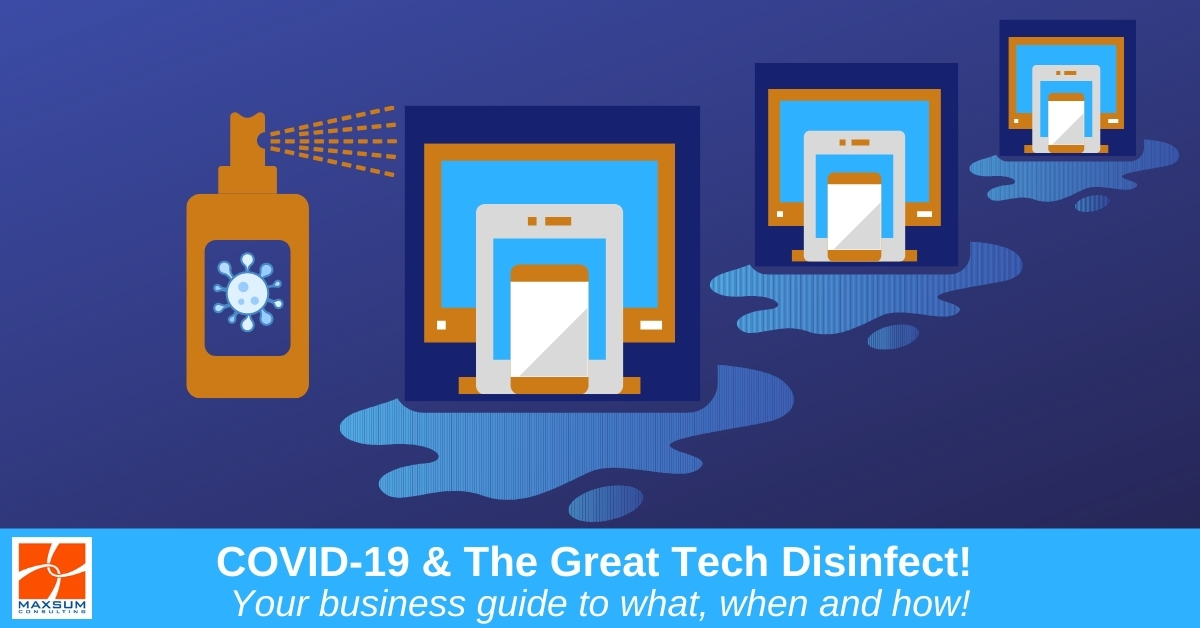Disinfecting your tech during COVID-19: What, when and how?
Remember the days when hot desking was the next-big thing and moving to shared devices and workstations made perfect financial and environmental sense?
Oh, for those days when cleaning up after eating lunch at your computer or wiping down your shared workstation at the end of the day was just about good office etiquette…not halting the spread of a life-threatening contagion…
Whilst COVID-19 has put paid to many of the in-person social joys of sharing time and space with people in the office, it has also caused a seismic shift in the way businesses can occupy the office space they have, as well as utilise and manage the resources and tools of their trade.
But this we already well and truly know. And luckily, we live in a country where we have access to reliable advice and resources we can action to keep our people safe.
(BTW If you need some great tips on how you could be safely and hygienically managing your resources during COVID-19 and beyond, check out some of the industry specific guides available from Safe Work Australia here.)
While most of the guidance does make reference to high-touch surfaces, phones, PC, and devices needing routinely daily cleaning and sanitisation, they often fail to address exactly how!
So, we’ve put together a few tips to supplement some of the great advice already out there to share with your team so you can make sure they know what they should be cleaning, when and how.
How COVID-19 has amped up the need for the great tech disinfect!
Businesses have already had to implement all new processes and cleaning regimes to both protect their essential workers that cannot work from home. But in many states where restrictions are easing, workplaces are now focused on safely and securely bringing their teams back onsite when the time comes.
As we’ve seen in Victoria, second and third waves are not just possible, they’re highly likely, and this means all those new COVID-19 related best practices need to be embedded now for the long haul. For “persons conducing a business or undertaking” this involves addressing the National COVID-19 Safe Workplace Principles, of which No 3. 4. and 5. specifically direct businesses, workers and other duty holders around health, safety and hygiene responsibilities in relation to COVID-19.
Turning to tech: How long does the virus survive on devices?
Research published in The New England Journal of Medicine and The Lancet found that COVID-19 can survive for hours and in some cases days outside a host depending on the type of surface it’s on.
The studies found that the virus can survive:
- up to at least 7 days on plastics and stainless steel
- up to 4 days on paper and glass
- up to 2 days on wood surfaces and even
- up to 24 hours on cardboard and
- up to 4 hours on copper surfaces.
Let’s just pause here for a moment. Now take a look around where your working or reading this article and the device you’re reading it on… Need a clean?
How can I safely clean my devices?
Pre-COVID-19 most hardware manufacturers suggested using a damp cloth and elbow grease to clean devices, and prominently emphasized their warnings that any harsh cleaning chemicals might impact the integrity of surface finishes and the cosmetic lifespan of the product.
But with a global pandemic at play, we’re less worried about cosmetic impact and more about the need to be taking a rigorous approach to cleaning and disinfecting our devices.
Does this mean breaking out the Domestos daily? Not necessarily…
Cleaning + Disinfecting + How often?
The general precautionary advice is to:
- Clean frequently touched areas and surfaces several times a day with hot water and detergent (aka “cleaning”) or disinfectant solution (aka “disinfecting” or “sanitising”). This includes EFTPOS equipment elevator buttons, handrails, tables, counter tops, doorknobs, sinks, shared device keypads.
- Instruct workers to clean their personal property and devices as often as possible with disinfectant or disinfectant wipes. This includes mobile phones, iPads, laptops, keyboards, screens in close proximity, mice, desk phones, headsets.
- For monitors, TVs and other devices that you sit further away from or might not use as often, once a week with a deep clean every month is likely sufficient.
Products labelled as “disinfectant” on the packaging are generally appropriate. Always read product instructions on how to dilute chemicals as stated on the packaging as well as any device or manufacturer instructions if you’re in doubt.
Deep Cleaning Your Devices
If you’ve never really given your devices a deep clean it might be time to start out on the right foot. Or in the unfortunate case that your workplace is closed for deep cleaning, you’ll probably need to deep clean what’s yours as well.
Here’s how:
Phones and tablets
Use rubbing alcohol or disinfectant wipes on the outside of your device. If your phone or tablet lives in a case, take it out and where possible thoroughly wash the case in hot soapy water and continue disinfecting the rest of your device.
Remember to NEVER submerge your phone or tablet in water or expose it to harsh chemicals like bleach. A simple disinfectant wipe will suffice.
Laptops
For the keyboard, casing and other high-touch surfaces, a wipe down with isopropyl alcohol, or ethanol will disinfect your device nicely, but be sure to take care when cleaning the screen.
Plastic screens may be suspectable to damage from alcohol or harsh cleaning chemicals so check the manufacturer’s cleaning recommendations, though you should be able to use an alcohol-based cleaner on most hybrid or convertible laptops.
Use a stylus? Don’t forget that too!
Keyboards & Mice
To get started on a keyboard deep clean, carefully remove the keys and clean them with a cloth, Q-tip and some isopropyl alcohol or ethanol.
You can very carefully used compressed air to blast any dust or crumbs out of the keyboard casing, and of course there are all kinds of funky vacuums and brushes you can buy online, but these aren’t necessary if you are happy to remove the keycaps yourself.
As for your mouse, much like the rest of your computer, it can be cleaned with rubbing alcohol or disinfectant. But for those hard-to-reach areas, dip a Q-tip or toothpick in alcohol and gently scrape out any lines, nooks and crannies that might be harbouring germs. Since your hand is often resting on the mouse, it’s a good idea to clean your mouse often.
Earphones and Headphones
In-ear earphones, for obvious reasons, will need more attention. You’ll need some rubbing alcohol and a Q-tip, damp cloth, and or cotton balls and once again, more rubbing alcohol.
Headphones are a little different as they don’t go in the ear, so a disinfectant wipe should be enough. Wipe all over the inner and outer ear cup being mindful of the material of the headphones so as not to damage it.
Always check the manufacturer’s recommendations for cleaning headphones and earphones as well.
PC Cases, Monitors and TVs
PCs harbour a lot of dust and for this reason they should be cleaned regularly anyway so as not to hinder heat dissipation and to preserve the computer’s components.
Whilst most PC cases are probably not “high-touch”, the power button might be! So don’t forget to give the power button a going over with a disinfectant wipe daily too.
It’s rare these days to see a glass-surfaced screen, so it’s important to be mindful of the harshness of chemicals used to clean monitors and TVs. Avoid using cleaning sprays, like Windex, or anything that contains detergent as this can permanently damage the display and cause fogginess and streaks. Instead, opt for a damp cloth and or disinfectant wipes safe to use on screens and monitors.
And lastly, the tech you’re likely to forget!
And while we’re at it, here are a few things that often get overlooked during any great tech disinfect. Make sure you’ve got these covered too.
Whose responsibility is it to clean these areas/items listed below and do you have a process in place to ensure it happens?
-
- Intercom systems
- Shared printers and copiers
- Shared laptops or fleet devices
- Conference room phones
- Room lighting, heating or cooling controls
- Conference or meeting room AV equipment (in essential work environments these may still be in use, albeit with density restrictions)
- Shared remotes
And what about?
-
- High-use charging adapters and cables
- Portable power banks
- Webcams
- In-car device holders and clamps
- GPS/touch screen control panels in shared/fleet vehicles
We hope that’s given you a few extra tips to get your started on providing some clearer advice to your team in relation to their tech tools and as well as some new processes you might need to be planning for as you transition back into the office – whatever that may look like!
While you’re planning a safe move back to the office, take a look at how you can do it securely as well. Take advantage of our limited-time-only Circle Back to IT Security Review.
Give us a call today on 1300 629 786 or Contact Us here.



